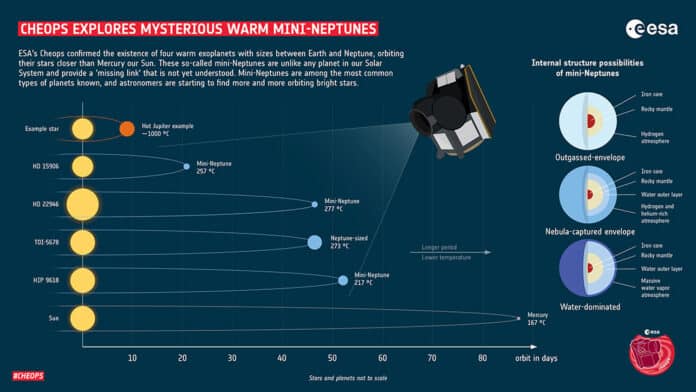An international team of astronomers- using the CHEOPS space telescope and the NASA satellite TESS- have identified the existence of four new exoplanets. These worlds are smaller and cooler and more difficult to find than the so-called Hot Jupiter exoplanets.
Dr. Hugh Osborn of the University of Bern and Dr. Solène Ulmer-Moll of the Universities of Bern and Geneva collaborated as NCCR PlanetS members to use the special synergy between CHEOPS and the NASA spacecraft TESS to find several elusive exoplanets. The planets, TOI 5678 b, and HIP 9618 c, have 4.9 and 3.4 Earth radii, respectively, and are roughly the same size as Neptune.
Amy Tuson from the University of Cambridge (UK) and Dr. Zoltán Garai from the “ELTE Gothard Astrophysical Observatory (Hungary)” were two other members of the international team that utilized the same method to find two similar planets in other systems.
The CHEOPS team created a mechanism to prevent wasting precious observation time in the hope of finding more transits because they suspected the existence of exoplanets. Based on the scant information offered by the transits seen by TESS, they created a targeted strategy. Based on this, Osborn created a program that suggests and ranks candidate periods for each planet.
Osborn says, “We then play a sort of ‘hide and seek’ game with the planets, using the CHEOPS satellite.”
“We point CHEOPS towards a target at a given time, and depending if we observe a transit or not, we can eliminate some of the possibilities and try again at another time until there is a unique solution for the orbital period.”
“It took five and four attempts, respectively, for the scientists to confirm the existence of the two exoplanets and determine that TOI 5678 b has a period of 48 days, while HIP 9618 c has a period of 52.5 days.”
The researchers could determine the masses of TOI 5678 b and HIP 9618 c as 20 and 7.5 Earth masses, respectively, using ground-based observations utilizing another technique termed radial velocity combined with the newly discovered restricted periods. Scientists can determine a planet’s composition by knowing its density, size, and mass.
Ulmer-Moll said, “For mini-Neptunes, however, density is not enough, and there are still a few hypotheses as for the composition of the planets: they could either be rocky planets with a lot of gas, or planets rich in water and with a very steamy atmosphere.”
“Since the four newly discovered exoplanets are orbiting bright stars, it also makes them targets of prime interest for the mission of the James Webb Space Telescope JWST, which might help to solve the riddle of their composition.”
“The four new planets we detected have much more moderate temperatures of ‘only’ 217 to 277ºC. These temperatures enable clouds and molecules to survive, which would otherwise be destroyed by the intense heat of Hot Jupiters. And they may potentially be detected by the JWST.”
“Smaller in size and with a longer orbital period than Hot Jupiters, the four newly detected planets are a first step towards the observation of transiting Earth-like planets.”
Journal References:
- Two Warm Neptunes transiting HIP 9618 revealed by TESS & Cheops by H. P. Osborn et al. is published in the Monthly Notices of the Royal Astronomical Society. DOI: 10.1093/mnras/stad1319
- TOI-5678 b: a 48-day transiting Neptune-mass planet characterized with CHEOPS and HARPS by S. Ulmer-Moll et al. is published in Astronomy & Astrophysics. DOI: 10.1051/0004-6361/202245478
- Refined parameters of the HD 22946 planetary system and the true orbital period of the planet d by Z. Garai et al. are published in Astronomy & Astrophysics. DOI: 10.1051/0004-6361/202345943
- TESS and CHEOPS Discover Two Warm Mini-Neptunes Transiting the Bright K-dwarf HD15906 by A. Tuson et al. is published in the Monthly Notices of the Royal Astronomical Society. DOI: 10.1093/mnras/stad1369
